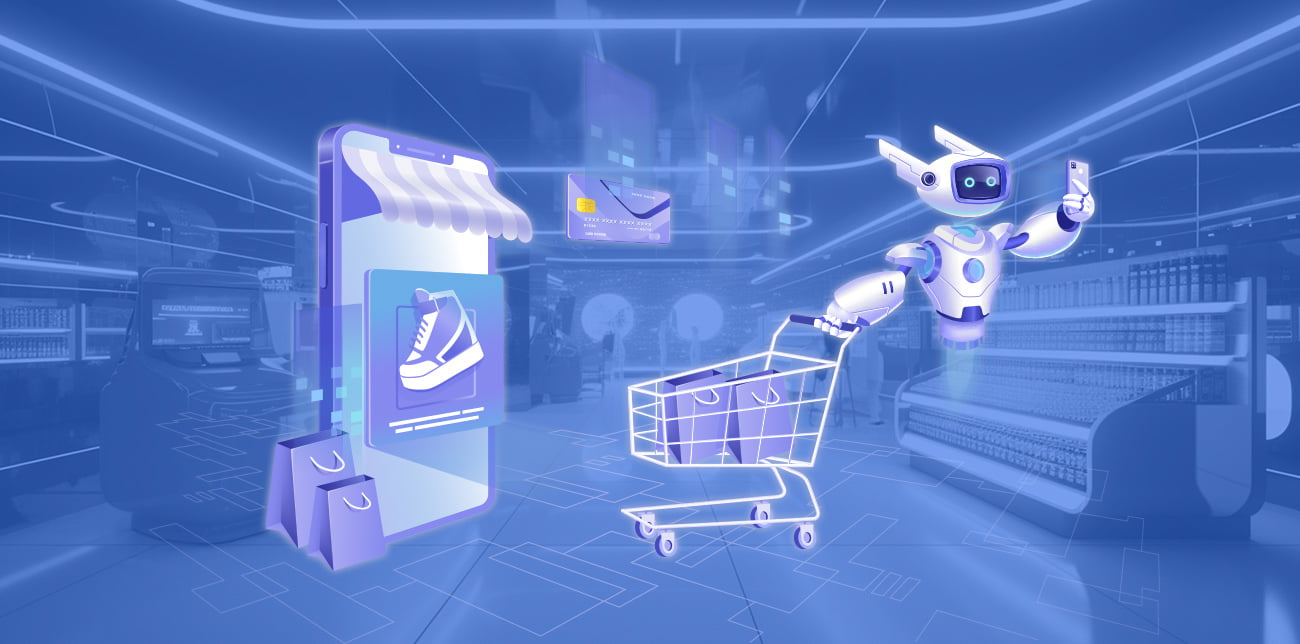
Retail is changing fast. Gone are the days when shopping meant just walking into a store, picking up what you need, and heading home. Today, it’s a mix of browsing online, trying things in-store, and expecting everything to feel seamless. The future of retail is all about blending the physical and digital worlds to create experiences that are convenient, personal, and fun. Let’s dive into what this looks like, why it matters, and how it’s shaping the way we shop.

Why Retail Is Evolving
Shopping has always been about meeting people’s needs, but those needs are shifting. Customers want speed, choice, and a personal touch. Online shopping exploded because it’s easy—you can buy a pair of sneakers at 2 a.m. without leaving your couch. But physical stores still have something special: the ability to touch, try, and feel products. The problem? Neither one is perfect on its own.
Online, you might struggle to know if a shirt will actually fit. In-store, you might not find your size or deal with long lines. Retailers are figuring out that the future isn’t about choosing one over the other—it’s about combining the best of both. Technology is the glue that makes this possible, and it’s changing how stores operate and how we shop.
The Rise of Omnichannel Shopping
You’ve probably heard the term “omnichannel.” It sounds fancy, but it just means making shopping feel the same whether you’re on your phone, laptop, or in a store. Imagine you’re browsing a website for a new jacket, add it to your cart, but don’t buy it. Later, you walk into the store, and they already know what you were looking at. Maybe they even have the jacket ready for you to try on. That’s omnichannel in action.
Retailers are using tech to connect all these dots. Apps, websites, and in-store systems talk to each other to track what you like, what you’ve bought, and what you might want next. For example, some stores let you order online and pick up in-store (called BOPIS—buy online, pick up in-store). It’s super convenient and saves you shipping costs. In 2025, this is becoming the norm, not the exception.
Tech That’s Changing the Game
Technology is the backbone of this retail revolution. Let’s break down some of the coolest tools shaping the future.
Augmented Reality (AR) for Trying Before Buying
Ever wished you could see how a couch would look in your living room without hauling it home? Augmented reality makes that happen. AR lets you use your phone or a store’s device to “place” products in your space or even “try on” clothes virtually. Makeup brands like Sephora have apps where you can test lipstick shades on your face using your phone’s camera. It’s like a digital mirror, and it’s making online shopping feel more like the real thing.
In stores, AR is popping up too. Some clothing stores have smart mirrors that let you see how an outfit looks in different colors without changing. It’s fun, saves time, and helps you make better choices.
Artificial Intelligence (AI) for Personalization
AI is like a super-smart shopping assistant. It analyzes your past purchases, browsing habits, and even social media likes to suggest products you’ll love. Online, you see this with “recommended for you” sections. In stores, AI can power things like chatbots on kiosks or even staff tablets that show your preferences.
For example, if you always buy eco-friendly products, AI can flag sustainable brands for you. It’s not just about selling more—it’s about making shopping feel personal. Retailers are also using AI to predict trends, so they stock what’s likely to sell, reducing waste and keeping prices reasonable.
Mobile Payments and Contactless Checkout
Nobody likes waiting in line. Mobile payments like Apple Pay or Google Wallet make checking out faster, and now stores are taking it further with “frictionless” checkout. Amazon Go stores, for instance, let you walk in, grab what you want, and leave—no scanning or cashier needed. Cameras and sensors track what you pick up, and your account is charged automatically.
This tech is spreading. Smaller stores are using apps or QR codes to let you pay without a cashier. It’s quick, safe, and makes shopping feel effortless.
Physical Stores Are Getting a Makeover
Physical stores aren’t going anywhere, but they’re not what they used to be. The future of retail is turning brick-and-mortar shops into experiences, not just places to buy stuff.
Stores as Showrooms
Some stores are becoming “showrooms” where you go to see and try products before buying online. Brands like Warby Parker let you test glasses in-store, but you can order them later from their app. These showrooms are designed to be fun and interactive, with less focus on carrying every single item in stock. It saves space and lets stores focus on creating a vibe.
Pop-Up Shops and Experiential Retail
Pop-up shops are temporary stores that create buzz. They might show up for a week to launch a new product or tie into a trend. These shops are often packed with Instagram-worthy setups, like photo booths or interactive displays. They’re not just about selling—they’re about creating memories.
Experiential retail takes this further. Think of stores with coffee shops, live music, or workshops. For example, some Nike stores offer fitness classes, while Lululemon hosts yoga sessions. These experiences make you want to hang out, not just shop and leave.
Smart Stores with IoT
The Internet of Things (IoT) is making stores smarter. Shelves with sensors can tell when stock is low and alert staff. Smart lighting adjusts to create the right mood. Even vending machines are getting upgrades—some use facial recognition to suggest snacks based on your age or mood (don’t worry, it’s anonymous!).
These upgrades make stores more efficient and pleasant. They also help retailers cut costs, which can mean better prices for us.
The Role of Data in Retail
Data is the secret sauce behind a lot of these changes. Every time you shop, you leave a digital trail—whether it’s clicking on a website, using a loyalty app, or paying with a card. Retailers use this data to understand what you want and how to make shopping better.
But here’s the thing: people are getting picky about privacy. Shoppers want personalized experiences, but they don’t want to feel like they’re being spied on. Retailers are walking a tightrope, using data to improve your experience while keeping it secure. In 2025, expect more transparency, like apps that let you control what data you share.
Sustainability and Ethical Shopping
The future of retail isn’t just about tech—it’s about values. Shoppers, especially younger ones, care about sustainability. They want to know where products come from, how they’re made, and if they’re eco-friendly. Retailers are responding by offering more sustainable options, like clothing made from recycled materials or packaging that’s biodegradable.
Technology helps here too. Blockchain can track a product’s journey from factory to store, so you know it’s ethically sourced. Apps like Good On You rate brands based on their environmental and labor practices, making it easier to shop with a conscience.
Challenges in Merging Physical and Digital
Blending physical and digital sounds great, but it’s not easy. For one, it’s expensive. Upgrading stores with smart tech or building seamless online systems costs a lot. Smaller retailers might struggle to keep up with giants like Amazon or Walmart.
There’s also the human factor. Not everyone loves tech. Some shoppers—especially older ones—prefer a traditional experience and might feel overwhelmed by AR mirrors or app-based checkouts. Retailers need to balance innovation with simplicity so no one feels left out.
And then there’s logistics. Offering same-day delivery or in-store pickup sounds awesome, but it’s a nightmare to coordinate. Retailers are investing in better supply chains, like local warehouses or delivery drones, to make it work.
What This Means for Shoppers
So, what does all this mean for you? Shopping is becoming more convenient and tailored to your life. You can browse online, try in-store, and get your stuff delivered how and when you want. Prices might stay reasonable as retailers use tech to cut waste. And you’ll have more power to shop with brands that match your values, whether that’s sustainability or supporting local businesses.
But it’s not all perfect. You might need to learn a few new apps or deal with occasional tech glitches. Privacy is something to watch—check those app permissions! Overall, though, the future of retail is about making shopping fit you, not the other way around.
Looking Ahead
The next few years will bring even more changes. Virtual reality (VR) could let you “walk” through a store from your living room. AI might get so good it predicts what you want before you do. And as 5G and IoT grow, everything will get faster and more connected.
Retailers that don’t adapt will struggle. The ones that thrive will be those that make shopping feel like an adventure, not a chore. Whether it’s a pop-up shop with a DJ or an app that knows your style, the future of retail is about bringing the best of both worlds—physical and digital—together.
In short, the future of retail is exciting. It’s a world where you can shop however you want, wherever you are, and feel like the experience was made just for you. So, next time you’re browsing online or strolling through a store, keep an eye out for these changes—they’re already here, and they’re only getting better.




